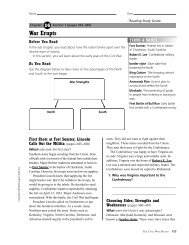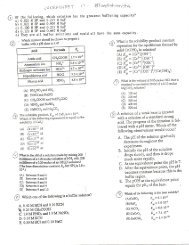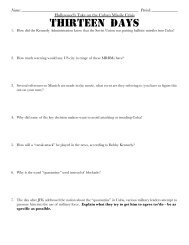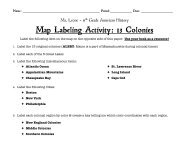Chapter 16 Text
Chapter 16 Text
Chapter 16 Text
You also want an ePaper? Increase the reach of your titles
YUMPU automatically turns print PDFs into web optimized ePapers that Google loves.
<strong>16</strong>.11 Lewis Acids and Bases 649<br />
Chemistry and Life The Amphoteric Behavior of Amino Acids<br />
Artrino acids are the building blocks of proteins. The general<br />
structure of amino acids is shown here, where different amino<br />
acids have different R groups attached to the central carbon<br />
atom.<br />
H R :O:<br />
I II ..<br />
H—N—C—C—O—H<br />
I<br />
H<br />
Amine group Carboxyl group<br />
(basic) (acidic)<br />
For example, in glycine, which is the simplest amino acid, R is<br />
a hydrogen atom, whereas in alanine R is a CHs group.<br />
H<br />
H,N—C—COOH<br />
H<br />
Glycine<br />
CHa<br />
H,N—C—COOH<br />
H<br />
Alanine<br />
Amino acids contain a carboxyl group and can therefore<br />
serve as acids. They also contain an NH2 group, characteristic<br />
of amines (Section <strong>16</strong>.7), and thus they can also act as bases.<br />
Amino acids, therefore, are amphoteric. For glycine, we might<br />
expect that the acid and base reactions with water would be as<br />
follows:<br />
Acid: H2N—CH2—COOH(ag) + H2O(1) ^=^<br />
H2N—CH2—COCT(flg) + H3O+(fl (Section 8.2) Crystalline amino acids (Figure<br />
<strong>16</strong>.14 T) have relatively high melting points, usually above<br />
200°C, which is characteristic of ionic solids. Amino acids are far<br />
more soluble in water than in nonpolar solvents. In addition, the<br />
dipole moments of amino acids are large, consistent with a large<br />
separation of charge in the molecule. Thus, the ability of amino<br />
acids to act simultaneously as acids and bases has important<br />
effects on their properties.<br />
A Figure <strong>16</strong>.14 Lysine, one of the amino acids found in<br />
proteins, is available as a dietary supplement.<br />
reactions, including those that do not involve proton transfer, as acid-base reactions.<br />
To avoid confusion, a substance like BF3 is rarely called an acid unless it is<br />
clear from the context that we are using the term in the sense of the Lewis definition.<br />
Instead, substances that function as electron-pair acceptors are referred to<br />
explicitly as "Lewis acids."<br />
Lewis acids include molecules that, like BF3/ have an incomplete octet of<br />
electrons. In addition, many simple cations can function as Lewis acids. For<br />
example, Fe3+ interacts strongly with cyanide ions to form the ferricyanide ion,<br />
Fe3+ + 6:C=N<br />
3'<br />
[Fe(C=N:)6]
















